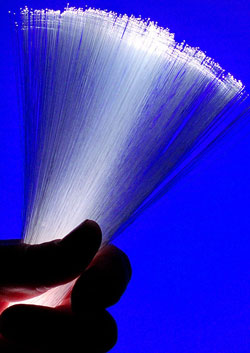There are many ways to transport your data from one place to another. The new gold standard has become Fiber Optic Ethernet lines, also known as EoF or Ethernet over Fiber. You’ll have a hard time beating this solution on a cost/performance basis.
 What is Fiber Optic Ethernet Transport?
What is Fiber Optic Ethernet Transport?Ethernet wasn’t part of the equation when fiber optic lines started to be buried in the ground and strung of utility poles for the telecom industry. The original standard was SONET (Synchronous Optical NETworking). This standard was designed to be backwards compatible with existing DS1 and DS3 multiplexed telephone calls in order to carry them on fiber. Why fiber? There's much more bandwidth in a single pair of optic fibers compared with legacy copper twisted pair, microwave and coaxial copper line.
Ethernet was born in the computer industry for local area networking. Transmitting this data outside the wired building or campus required a protocol conversion so that T-carrier and SONET fiber could carry packets instead of digitized phone calls. Decades later the efficiency of carrying Ethernet directly instead of first converting to an older protocol was standardized. Two varieties emerged. Ethernet over Copper and Ethernet over Fiber. For shorter distances, wireless Ethernet over line of sight microwave, laser, and radio systems such as WiFi and WiMAX were also developed.
The Immense Advantage of Fiber Optic Ethernet
Carrier Ethernet has been adopted by competitive telecom providers as well as the legacy telco companies. The first advantage is that it is directly compatible with computer networks. It’s Ethernet, after all. There is no need to deal with the inefficiency of converting back and forth between some other protocol. Just plug in your network and go. If you order a service such as E-LAN, you can interconnect your LANs at multiple locations as if they were on one big network.
The second big advantage is that Ethernet is easily scalable. When you order traditional MAN (Metropolitan Area Network) or WAN (Wide Area Network) services, you get a line with a fixed speed. T1 is 1.5 Mbps, DS3 is 45 Mbps and OC3 is 155 Mbps. That speed determines how much data you can transmit per unit of time and it also determines the price you pay. What’s more, if you outgrow your line service, you have to upgrade to another line standard and get all new termination equipment. A higher speed service may or may not even be available for upgrade.
With Fiber Ethernet you really don’t have an upper limit. Each fiber strand can carry maybe 10 Gbps and could be wavelength multiplexed with dozens or even hundreds of 10 Gbps channels. Fibers are so small that cable bundles might have over a hundred fiber strands. It’s going to be pretty hard to run out of capacity.
The nice part is that you don’t have to pay for all of that capacity. You order a service level, say 100 Mbps or 1 Gbps, and that’s what you are charged for. If you find that you need more, you can get upgraded to a higher service level with a phone call or even with an online portal. You can get as much bandwidth as the port capacity that is installed at your location. That’s typically 1 Gbps minimum, with options for 10 Gbps or even 100 Gbps.
Best Advantage of All
Thanks to competition in the marketplace and the enormous inherent capacity of optic fibers, the price you pay per Mbps is lower than it has ever been, and usually far better than with older SONET technology. That price is for highly reliable circuits, often with service level guarantees. The bandwidth is both symmetrical, same upload and download speed, and dedicated for your use only.
Competing Bandwidth Options
If you only need bandwidths of 10 or 25 Mbps, Ethernet over Copper can give you similar advantages to Ethernet over Fiber. At lower speeds, 1.5 or 3 Mbps, a T1 line is still attractive.
The bargain basement bandwidth options include business cable broadband, wireless Internet service providers, Satellite broadband, telephone DSL lines, and cellular broadband. All of these were developed for the price sensitive consumer market and then offered to small businesses with needs that aren’t too demanding. Prices per Mbps are very attractive. Most of this comes from the fact that bandwidth is shared among users and not dedicated to a single customer. Bandwidth is also non-symmetrical. Download speeds are typically 10x upload speeds.
Wireless services tend to have pretty restrictive usage limits and are not suitable for downloading big software updates or transferring large files. Satellite is available nearly everywhere, but has latency issues that make it difficult to use for telephone and other real-time services.
Note that these services are almost always Internet access only. Fiber Ethernet can be set up as dedicated Internet access or point to point private lines.
What bandwidth service is best for your business? You have many more options that you may realize and pricing that could be better than expected. Find out now, what Fiber Optic Ethernet services are available for your business locations.

